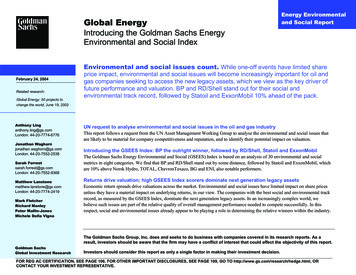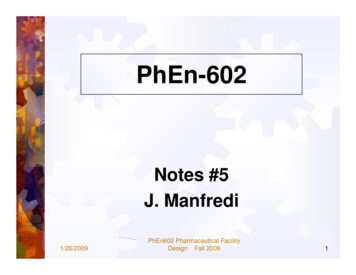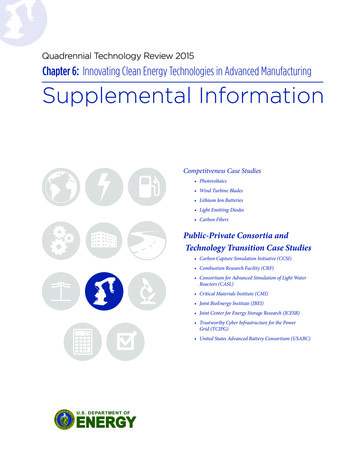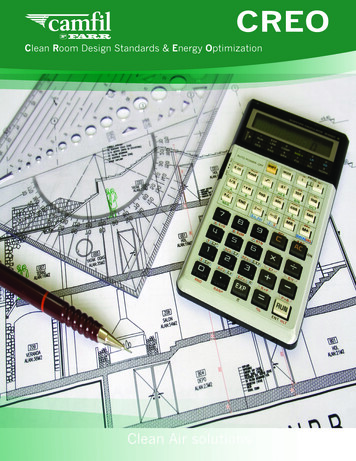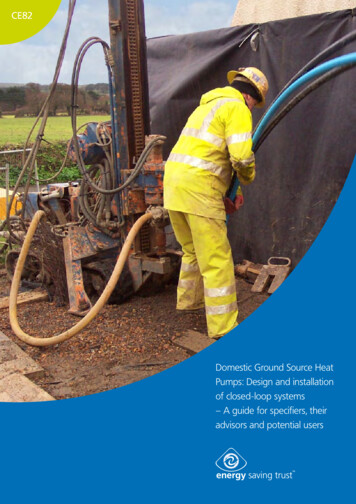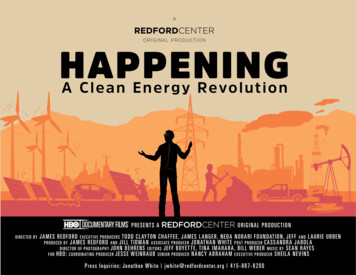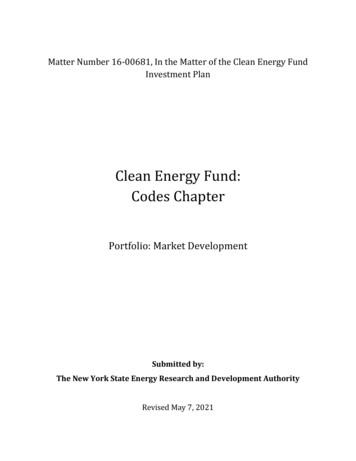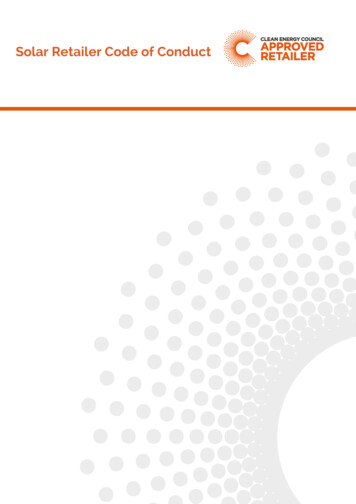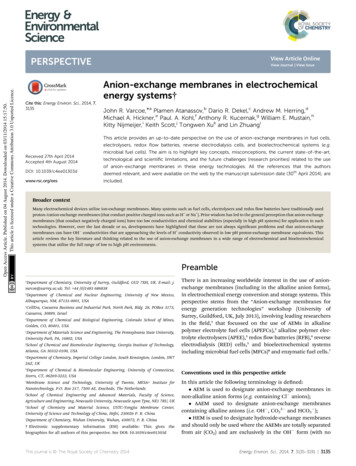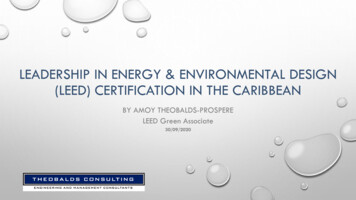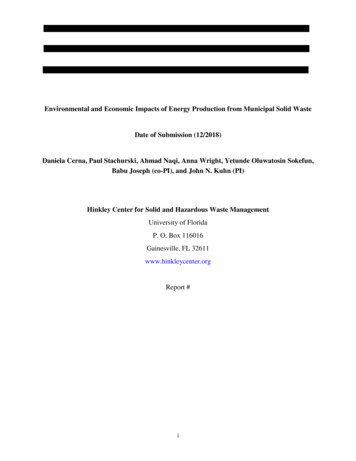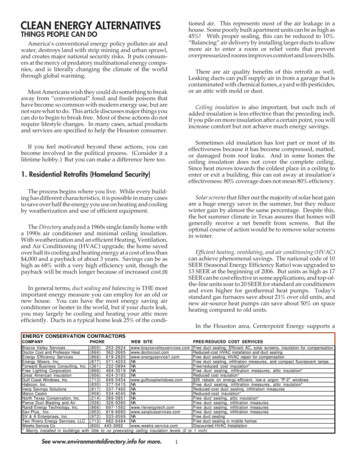
Transcription
CLEAN ENERGY ALTERNATIVEStioned air. This represents most of the air leakage in ahouse. Some poorly built apartment units can be as high as45%! With proper sealing, this can be reduced to 10%.“Balancing” air delivery by installing larger ducts to allowmore air to enter a room or relief vents that preventoverpressurized rooms improves comfort and lowers bills.THINGS PEOPLE CAN DOAmerica’s conventional energy policy pollutes air andwater, destroys land with strip mining and urban sprawl,and creates major national security risks. It puts consumers at the mercy of predatory multinational energy companies, and is literally changing the climate of the worldthrough global warming.There are air quality benefits of this retrofit as well.Leaking ducts can pull supply air in from a garage that iscontaminated with chemical fumes, a yard with pesticides,or an attic with mold or dust.Most Americans wish they could do something to breakaway from “conventional” fossil and fissile poisons thathave become so common with modern energy use, but arenot sure what to do. This article discusses major things youcan do to begin to break free. Most of these actions do notrequire lifestyle changes. In many cases, actual productsand services are specified to help the Houston consumer.Ceiling insulation is also important, but each inch ofadded insulation is less effective than the preceding inch.If you pile on more insulation after a certain point, you willincrease comfort but not achieve much energy savings.Sometimes old insulation has lost part or most of itseffectiveness because it has become compressed, matted,or damaged from roof leaks. And in some homes theceiling insulation does not cover the complete ceiling.Since heat moves towards the coldest place in a ceiling toenter or exit a building, this can eat away at insulation’seffectiveness: 80% coverage does not mean 80% efficiency.If you feel motivated beyond these actions, you canbecome involved in the political process. (Consider it alifetime hobby.) But you can make a difference here too.1. Residential Retrofits (Homeland Security)The process begins where you live. While every building has different characteristics, it is possible in many casesto save over half the energy you use on heating and coolingby weatherization and use of efficient equipment.Solar screens that filter out the majority of solar heat gainare a huge energy saver in the summer, but they reducewinter gain by almost the same percentage. Despite this,the hot summer climate in Texas assures that homes willgenerally receive a net benefit from screens. But theoptimal course of action would be to remove solar screensin winter.The Directory analyzed a 1960s single family home witha 1990s air conditioner and minimal ceiling insulation.With weatherization and an efficient Heating, Ventilation,and Air Conditioning (HVAC) upgrade, the home savedover half its cooling and heating energy at a cost of less than 4,000 and a payback of about 3 years. Savings can be ashigh as 68% with a very high efficiency unit, though thepayback will be much longer because of increased cost.(1)Efficient heating, ventilating, and air conditioning (HVAC)can achieve phenomenal savings. The national code of 10SEER (Seasonal Energy Efficiency Ratio) was upgraded to13 SEER at the beginning of 2006. But units as high as 17SEER can be cost effective in some applications, and top-ofthe-line units soar to 20 SEER for standard air conditionersand even higher for geothermal heat pumps. Today’sstandard gas furnaces save about 21% over old units, andnew air-source heat pumps can save about 50% on spaceheating compared to old units.In general terms, duct sealing and balancing is THE mostimportant energy measure you can employ for an old ornew house. You can have the most energy saving airconditioner or heater in the world, but if your ducts leak,you may largely be cooling and heating your attic moreefficiently. Ducts in a typical home leak 25% of the condi-In the Houston area, Centerpoint Energy supports aENERGY CONSERVATION CONTRACTORSCOMPANYPHONEWEB SITEFREE/REDUCED COST SERVICES(800) 253-2624 www.brazosvalleyservices.comBrazos Valley ServicesDoctor Cool and Professor Heat(866) 362-2665 www.doctorcool.comEnergy Efficiency Services(866) 619-2820 www.energyservice1.comEnergy Misers, Inc.(877) 571-4203 NAForward Business Consulting, Inc. (361) 232-0894 NAFree Lighting Corporation(866) 484-3519 NAGreat American Insulation(956) 424-3193 NAGulf Coast Windows, Inc.(713) 849-5454 www.gulfcoastwindows.comHabicon, Inc.(830) 377-5415 NAInerg Savings Solutions(817) 337-7460 NAMarco Castro(956) 534-4045 NANorth Texas Conservation, Inc.(214) 389-5851 NA(936) 326-9380 NAPierce Duct Blasting and AirRandl Energy Technology, Inc.(866) 697-1582 www.rlenergytech.comSav-Plus, Inc.(903) 819-6680 www.savplusservices.comSV & A Enterprises, Inc.(972) 533-6569 NATwo Rivers Energy Services, LLC (713) 882-6484 NAWeeks Service Co(800) 443-3992www.weeks-service.com* Mainly installed in buildings with little to no preexisting ceiling insulation levels (0 toSee www.environmentaldirectory.info for more.1Free duct sealing; Efficient AC, solar screens, insulation for compensationReduced-cost HVAC installation and duct sealingFree duct sealing; HVAC repair for compensationFree duct sealing, infiltration measures, and compact fluorescent lampsFree/reduced cost insulation*Free duct sealing, infiltration measures, attic insulation*Reduced cost insulation* 25 rebate on energy-efficient, low-e argon "P-2" windowsFree duct sealing, infiltration measures, attic insulation*Reduced-cost duct sealing, infiltration measuresReduced-cost insulation*Free duct sealing, attic insulation*Free duct sealing, infiltration measuresFree duct sealing, infiltration measuresFree duct sealing, infiltration measuresFree duct sealingFree duct sealing in mobile homesDiscounted HVAC Installation1 inch)
hold great potential for energy savings. There are now 2companies that manufacture these smaller water-cooledunits, Allied Energy (Austin, TX), and Freus (Vinton, TX).These units have the capability of raising the SeasonalEnergy Efficiency Ratio (SEER) of an air conditioner to ashigh as 22 (estimated). This represents a 41% savings overtoday’s national minimum standard, and at least a 55%savings over older units. They carry an increased premiumof about 1,000. Thus the payback for a home using 1,500hours a year of air conditioning is about 4 years. There isa slightly increased water cost, as the unit uses about 2-4gallons an hour. But this would only add about 9-18 peryear to the cost of operation.Water cooled systems also have the capability of coolingseveral air conditioners in sequence in a large home, smallbusiness, or apartment building. This type of installationcarries an even lower premium because the increased costis divided over several units.residential conservation incentive program. It is carriedout by a list of pre-approved conservation contractors,most of whom are listed on the previous page. For moreinformation on the program, visit Centerpoint's Web mlThe units are made of fiberglass and have an automaticpurge function to prevent growth of mineral scale. Thiswater can be reused for landscaping, further loweringcosts. They do not require freeze protection and use avariable speed fan to match the air conditioning load andmaximize efficiency. Water-cooled units often extend thelife of an air conditioning system by allowing it to runmuch cooler. (A doubling of equipment lifetime has beenspeculated.) Both companies carry 10-year warranties onthe compressor. Allied Energy carries a 3-year warrantyon parts, while Freus carries a parts warranty of 10 years.2. Unconventional Heating & CoolingEquipmentAfter upgrading ducts and weatherizing your structure, installing high efficiency HVAC can whittle downcomfort conditioning energy use by even larger amounts.In many situations (particularly older buildings), it isliterally possible to cut energy use by 50-75% with weatherization, duct sealing, and advanced heating and coolingequipment.The increase in water use has been a source of concern,particularly in water-short regions of the country. Freuspredicts its increased water use in hot climates to be about7,500 gallons a year. To put this figure in perspective, ifevery individual residence in the city of Austin where I livewere to use water-cooled air conditioners at this rate (manywould use less), it would increase the total water use inAustin by 6%. (It would be lower if the purge water wereused for landscaping).Air conditioner efficiency is often judged by a SeasonalEnergy Efficiency Rating (SEER). In 1970, this was estimated to be 7 SEER (or less). In 1990, the national standardbecame 10 SEER; beginning in 2006, it is 13 SEER. Butstandard (air cooled) units are now made with SEER levelsas high as 20, though these top-of-the-line units carry ahigh premium. Unconventional units discussed belowalso have high efficiencies and are often cost effective.The makers of Freus claim the equipment actually conserves water in many cases, since power plants in certainregions use more cooling water per kilowatt hour in theproduction of electricity than water-cooled air conditioners use onsite. Since municipal water supplies use a lotmore infrastructure and energy to process and transportthan power plant cooling water, it is hard to draw a directcomparison. But in actual water used, there is often apositive balance with this type of HVAC equipment.Water-Cooled Air Conditioners(2)Modern air conditioners are “air-cooled,” that is, theytake heat from the inside of a building through the evaporator coil and deposit it to the outside of a building throughthe condensing coils where the heat is released to thesurrounding air. This is a relatively inefficient way todissipate heat. Cooling towers, which cover the condensing coils with ambient temperature water, are much moreefficient. Consider how quickly you would cool off if youimmersed yourself in 80 water instead of 80 air.For more information contact:Allied Energy . (512) 443-39381903 Westridge DriveAustin, TX 78704Wholesale and retail contactCooling towers are nothing new. Many large commercial air conditioners use them to dissipate the massive heatbuildup they must handle. But residential-sized coolingtowers are an uncommon phenomenon, even though theyIndividual Action – Unconventional HVAC2
they have a SeasonalEnergy EfficiencyRatio (SEER) of approximately 23 compared to the newnational standard of13 SEER and a heating Coefficient ofPerformance (COP)of about 5 comparedto a standard airsource heat pumpCOP of 2 or 3. And ground and water source equipmentdoes not need electric “strip” backup heat, which supplements air-source units when the outside air falls nearfreezing temperatures, raising winter bills. (Air sourcecompressors function less efficiently as temperatures fall.)Some units can also heat water at this same high efficiency.Freus . (915) 886-90508240 Doniphan Dr.Vinton, TX 79821www.freus.comDirect purchase for building owners or contractorsMulti-Split SystemsDuctless or “Multi-Split” systems are gaining popularity, particularly when houses add rooms, and in houseswhere heating and cooling one room at a time is preferable.These look a little like window air conditioners, but without a window. The only wall or ceiling penetration is forthe refrigerant line that attaches to the wall-mounted airhandler.These units allow individual rooms to be selectivelyheated and cooled as needed, and eliminate duct energylosses from leakage and attic exposure. Moreover, theyhave variable speed delivery (which supplies less conditioned air when less is needed) and occupancy sensors thatcan turn conditioned air off in rooms that no one occupies.As such, the equipment “follows the load” and the peoplearound a home to save even more energy.Since most homes are not located next to large bodies ofwater, ground source applications are the most typical usefor this technology. Pipe can be laid either horizontally(preferably 5-6 feet below the earth) or vertically, with awater drilling apparatus creating bore holes. Currenthorizontal technology requires a lot of space, as much as5,000 square feet per average house. This means that it isbasically used in large lot houses, and usually new houses,where there is no landscaping that needs to be replaced.Vertical drilling can go 60 to 300 feet below the surface.While the equipment itself is roughly 25% more expensive than conventional HVAC units, there are inherentsavings in installation, particularly duct installation andelectric wiring (since the equipment can accommodatesmaller amperage).Installing the ground pipe is the major additional cost ofthe technology. It can add approximately 1,800 per ton ofair conditioning for vertical installations. This amount canbe reduced though drilling in volume (such as installing awhole subdivision at once) or apportioning some of thecost to a geothermal heat pump water heater.The most efficient unit on the market at this time is madeby Daikin: a heat pump with a SEER of 16 and a HeatingSeasonal Performance Factor of at least 7.2. The largest unithas up to 1.5 tons of capacity and will supply 2 averagerooms at varying levels of temperature with a maximumcombined area of 1,000 square feet. The winter heatingmode will provide heat down to 5 F below zero. But coldertemperatures can be accommodated with strip heat backup installed separately.The savings are dramatic. This equipment enables airconditioning and heat pump efficiencies almost doublethat of the 2006 appliance standards.And they generally have a much longer life than standard air source heat pumps and air conditioners. Theplastic pipe buried in the ground or submerged in watercarries a warranty of 50 years. And the compressor itself isexpected to last much longer due, among other things, toless stress on equipment. Outdoor air temperature extremes of 20 F in the winter and 100 F in the summer areno longer straining the system, as the ground stays aconstant temperature year round. Some have predicteddouble the lifetime.The current Daikin representative for the Houston areais listed below.Heat Transfer Solutions, Inc. . (832) 328-1010Darren Bentley10110 W. Sam Houston Pkwy. S., Suite 100Houston, TX 77099Geothermal Heat PumpsThis technology is not untested in the marketplace.About 100,000 of these units were installed in 2005, andabout a million have been installed in the U.S. However,this number represents less than 1% of all central HVACsystems in U.S. buildings.(3)Similar to conventional air-source heat pumps, whichmove heat from the air to heat or cool a building, geothermal heat pumps move hot or cold temperatures throughplastic pipes buried in the earth or submerged underbodies of water such as lakes or ponds. The earth stays atrelatively constant and moderate temperatures (50 to 70 F)a few feet below the surface.In regions where utilities have specific programs topromote them, geothermal heat pumps have excellentratings from residential utility customers - as high as 99%These heat pumps greatly reduce energy use. In Austin,Individual Action – Unconventional HVAC3
GEOTHERMAL HEAT PUMP CONTRACTORSClimatemaster – www.climatemaster.comAccurate Air9745 Bent Oak DriveDominair Heating & Air12122 Knigge Cemetary Rd.Egan & Hinson5303 Glenmont, Suite FGeothermal Advantage23819 Spring GumJarrar & Company, Inc.9119 Emmott RoadMLN Service Co.3931 Ann ArborFL Heat Pump – www.fhp-mfg.comExtreme Air4727 Strack RoadMLN Service Co.3931 Ann ArborWater Furnace – www.waterfurnace.comDominair Heating & Air12122 Knigge Cemetary Rd.Egan & Hinson5303 Glenmont, Suite FGeothermal Advantage23819 Spring GumGulf Coast Air Conditioning5926 HeffernanTrane – www.trane.comAir Champions10014 Gilson LaneMLN Service Co.3931 Ann ArborGeothermal DrillersEnlink Geoenergy (Commercial Only) 16430 Park Ten PlaceHouston, TX 77040Cypress, TX 77429Houston, TX 77081Spring, TX 77373Houston, TX 77040Houston, TX 77063(832) 590-5700(281) 855-7418(713) 666-1101(281) 353-1488(832) 467-4750(713) ncompany.comHouston, TX 77069 (281) 580-4239Houston, TX 77063 (713) 782-3633NAwww.mlncompany.comCypress, TX 77429Houston, TX 77081Spring, TX 77373Houston, TX , TX 77086Houston, TX 77063Houston, TX 77084customer satisfaction. To date, most of these units havebeen in the service areas of Northern utilities. But they aregaining ground in certain southern regions such as coastalFlorida, where the salt air from the ocean can cause accelerated deterioration of outdoor metal compressors.(281) 855-7418(713) 666-1101(281) 353-1488(713) 644-1861There are at least 2,000CF products on the Ameri(281) 440-8077 NAcan market made by about(713) 782-3633 www.mlncompany.com140 companies. Their use isnot limited to conventional(888) 855-6901 www.enlinkgeoenergy.comfixtures. They can be combined with reflectors to replace floodlight (PAR) lamps,which are also used in recessed “can” fixtures. Other newuses include small lamps for bathroom vanities, advertising signs, and even chandeliers.When looking for these products, the minimum qualitystandard you should seek is the Energy Star label. This is avoluntary rating program run by the U.S. EnvironmentalProtection Agency that grants its approved label to companies whose products pass third-party testing. These products have to meet specifications for longevity, light outputover time, color quality, and energy usage.Geothermal heat pumps are even more cost effective incommercial buildings where heating, cooling, and refrigeration equipment run more hours. Lubbock ChristianUniversity has retrofitted 3 of its buildings with greatsuccess, and has plans to install these heat pumps throughout the campus. Public schools in North Central Texashave experienced monetary savings on energy bills of asmuch as 62% compared to schools with conventionalHVAC.Consumers can also look for products with specialfeatures, including lamps that: 1) work with dimmers; 2) fitinside enclosed fixtures; 3) imitate “3-way” lamps; and 4)closely resemble natural light (see discussion below).One interesting concept devised to avoid the high firstcost of these units is to have electric utilities own theunderground pipe, and then “lease” it for a small monthlycharge to the consumers. This would be an advance on theconcept of air conditioner rebates since utilities couldrecoup all of their investment.Since these characteristics are not found everywhere,the Directory has compiled a chart of unique CF products.This chart does not include every manufacturer, but it doesinclude most of the major ones sold in this region.3. Compact FluorescentsWhile most grocery stores, department stores, and hardware stores will have some models, the sizes and characteristics you seek may not be on their shelves. When trying tolocate special bulbs, it is a good idea to consult the Internet to getthe specs that you need (e.g., size, dimming, full spectrum, etc.)and then special order them, or call the retailer in advance.Since the early 1980s, fluorescent lamps have been madethat screw into incandescent light bulb sockets. Dubbed“compact fluorescents,” (CFs) they save 66–75% of theenergy used by incandescent bulbs. While higher in cost,they pay for themselves in energy savings, lamp replacement, and maintenance time.This chart includes CFs that best resemble sunlight.Note that the “full spectrum” category lists both ColorTemperature (in degrees Kelvin) and Color RenderingIndex. Full spectrum light is defined here as a ColorTemperature of 5000 K or above and a Color RenderingI
units, Allied Energy (Austin, TX), and Freus (Vinton, TX). These units have the capability of raising the Seasonal Energy Efficiency Ratio (SEER) of an air conditioner to as high as 22 (estimated). This represents a 41% savings over today’s national minimum standard, and at least a 55%
